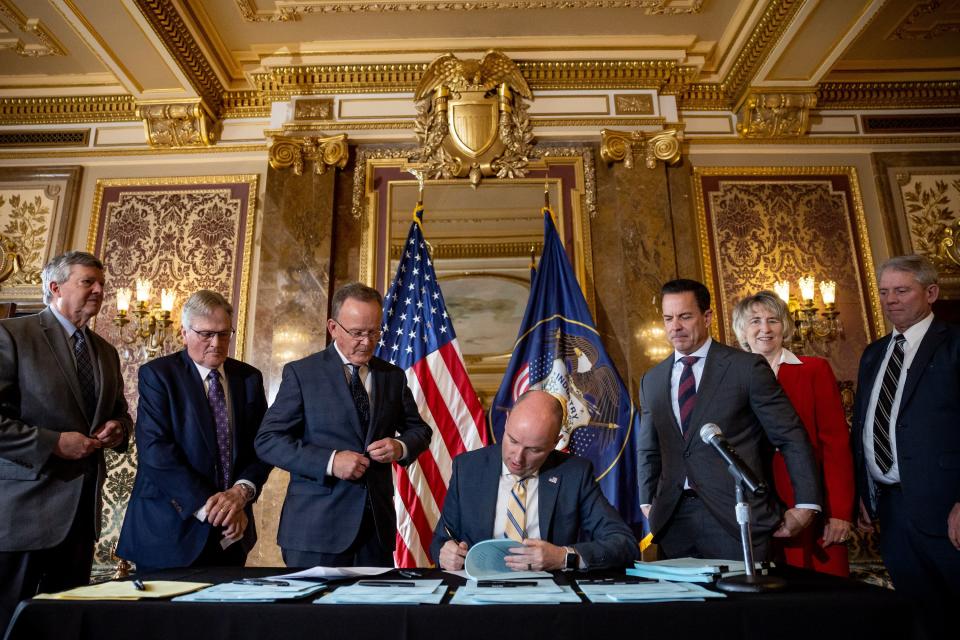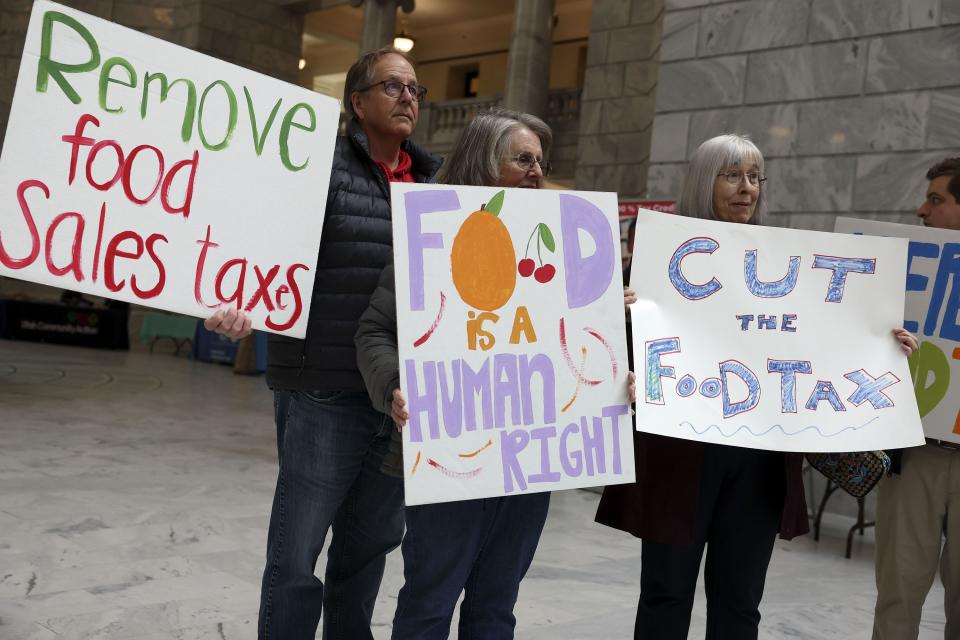Will Utahns have to keep paying sales tax on food? It’s complicated

So is there still sales tax on food in Utah or not?
That’s a question Utahns may be asking after removing the state’s share of sales tax on food became part of the GOP-dominated Utah Legislature’s $400 million tax cut package, passed at the end of the 2023 general session and signed by Gov. Spencer Cox.
The answer, though, is yes.
Utah still charges sales tax on food — just like only about a dozen other states — even though the other tax cuts passed by lawmakers, including dropping the state income tax rate from 4.85% to 4.65%, are now in place.
Why? It’s complicated. For starters, this is only about the state’s share of sales tax on food.
That’s 1.75% of the 3% total tax charged statewide on food since 2008, about $200 million a year. The rest, 1.25%, is set to continue to be collected and distributed to local governments, so that portion of the food tax isn’t going away.
Whether the state’s share of the sales tax on food is actually lifted won’t be decided until November 2024, when voters will be asked to approve an amendment to the Utah Constitution also passed this session.
Related
But the amendment is about income tax, not sales tax.
It would remove the earmark on using state income tax collections for education. That longstanding earmark was last altered in 2020, when voters approved allowing income taxes to also be used to support children and individuals with disabilities.
So how does that affect the sales tax on food? Lawmakers decided to link the issues last session, adding language making the removal of the state sales tax on food contingent on passage of the income tax amendment.
If voters say yes to the amendment, the state will end its 1.75% tax on food on Jan. 1, 2025. If voters say no, nothing changes at Utah’s grocery or convenience store cash registers.

Did lawmakers ‘sweeten the deal’ for voters?
Although the linkage is complicated, the reasoning behind it seems to be pretty simple.
Utahns made it clear how much they hate the sales tax on food during the successful effort a few years ago to roll back a legislative tax reform package that would have increased sales taxes on food as well as gas and some services while slashing income taxes.
The 2020 Legislature repealed the tax reform package that was intended to correct a structural imbalance in the state budget, caused by income tax collections rising faster than sales tax receipts used to cover the cost of most government services.
At the same time, Utahns also have consistently shown strong support for funding schools, suggesting that amending the Utah Constitution to remove a guarantee that income taxes go to public and higher education could run into some trouble.
In fact, a new Deseret News/Hinckley Institute of Politics poll found the amendment itself has the support of just over a third of Utahns, while half oppose it and the rest aren’t sure.

House Majority Leader Mike Schultz, R-Hooper, insists lawmakers weren’t trying to win support for the constitutional amendment by tying its passage to getting rid of the state sales tax on food.
“That’s not the intent,” Schultz said. “There’s no truth to it being used as a carrot.”
Instead, he said House members were focused on taking the state sales tax off food, not removing the constitutional earmark on how income taxes are spent, an issue that otherwise likely wouldn’t have come up until the end of the decade.
That’s when the spending flexibility afforded by the last constitutional change to the earmark was expected to run out, Schultz said, and taking another $200 million from the state’s general fund by removing the state sales tax on food just moved up the timetable.
“There’s been a big push to take the sales tax off food from both sides, honestly, from the right and from the left,” he said. “So we just felt like, OK, if that’s something the public wants, something they want to do, we want to be accommodating to that.”
Schultz, who said it would have been “irresponsible” to do that without the spending flexibility, amended a House bill removing the state food tax to connect it to the constitutional amendment even before it was assigned to committee.
That bill, HB101, was sponsored by Rep. Judy Weeks Rohner, R-West Valley City, a leader of the referendum that threatened to overturn the tax reform package three years ago. Her bill passed the House, but was folded into the tax cut bill, HB54, in a Senate committee.
Related
“It’s a compromise. This way it gives the people a choice,” Rohner said about what happened to her bill, which initially had called for stripping the state sales tax from food as of July 1. “We do the best we can with what we have to work with.”
Sen. Curt Bramble, R-Provo, said there were political reasons for combining the issues.
He said the resolution putting the constitutional amendment on the ballot may not have passed the House without being connected to the food tax, and Rohner’s bill would have failed in the Senate, which has long opposed what’s seen as shrinking the sales tax base.
Bramble also doesn’t want to label the promise of taking the sales tax off food as a carrot, offered so voters will accept the stick of amending the constitution to give lawmakers free rein over spending income taxes.
“It will be spun any one of a number of ways,” the longtime senator said, describing putting the two issues together as the only way “from a fiscal responsibility point of view” that lawmakers can make removing the state sales tax on food work.
Still, Bramble acknowledged, it can be seen as a way to “sweeten the deal or find a compromise that everyone can choke down and live with. Isn’t every compromise offering enough carrots that everyone gets something that they want, but along with the carrots comes something they may not like?”

A ‘complicated and somewhat uncertain trade-off’
Utah Education Association President Renée Pinkney said the tax changes should be treated separately.
“They’re linked because they’re both a tax. However, it’s a very imbalanced trade-off. So $200 million is roughly what the state portion of food tax raises. And the income tax is $8 billion,” Pinkney said.
But lawmakers have used what she called an “if this, then that” formula this past session to pass a $6,000 pay raise for teachers tied to a new, $8,000 school choice scholarship program in a single bill.
Even the previously voter-approved state constitutional amendment allowing income taxes to also be used for programs for children and people with disabilities was tied to a promise that schools could count on funding to cover needs like inflation and enrollment growth.
Pinkney said it’s going to take a “huge educational lift” to make sure voters understand what’s going on, including that they’ll still be paying sales tax on food if the amendment passes, just not as much.
Even more critical, she said, is that everyone is clear on exactly how the constitutional amendment would impact public education funding. Lawmakers still have another legislative session to make changes to the amendment before it goes to voters.
“As an educator, as a social studies teacher for 28 years, that is what is the most important, is making sure that we have an informed voting population so they know what they are potentially giving up and what the trade off is,” Pinkney said.
It’s something UEA’s 18,000 members are also sorting out. Later this month, the UEA’s annual meeting of delegates will consider their options, which could range from rejecting the constitutional amendment outright to coming up with language they’d rather see.
Chris Karpowitz, co-director of Brigham Young University’s Center for the Study of Elections and Democracy, said he is “skeptical that voters would approve such a big change in funding for schools on its own” and called linking the two issues unusual.
Related
“Voters will have to balance the prospect of lower grocery bills against their view of how it will affect education in the state,” Karpowitz said. “Typically, these two issues are separate but now voters will have to think of them together.”
That means voters will face what he said is “a complicated and somewhat uncertain trade-off — is it no tax on food for the status quo in education funding, or is it no tax on food in exchange for a decrease in the state’s commitment to public education?”
While the food tax won’t be on the ballot, the issue should be “quite popular among many Utahns,” the political science professor said, adding he expects both supporters and opponents of the constitutional change to “campaign vigorously.”
Unlike amending the state constitution, changes to the state sales tax on food only require legislative action. That means even if voters approve lifting the restrictions on spending income taxes next year, there’s nothing stopping lawmakers from restoring the food tax.
But that’s not likely to happen, said Rep. Steve Eliason, R-Sandy, the sponsor of the tax cut bill that links the two issues and the chairman of the House Revenue and Taxation Committee.
“Me and all my colleagues would feel like we betrayed the voters if we then went back and raised sales tax on food after that. I mean, the Legislature can do anything,” Eliason said, but know that “if voters don’t like what we’re doing, they can vote us out.”

What if voters reject the constitutional amendment?
The tax reform referendum underscored how much Utahns dislike any tax increase. Still, when Utah voters approved a Medicaid expansion initiative in 2018, they agreed to raise the state sales rate from 4.7% to 4.85%.
It would take a slightly larger increase in the state sales tax rate, from the current 4.85% to about 5.05%, to collect enough revenues to cover the $200 million that would be lost by removing the sales tax on food.
Lawmakers appear to have little interest in going that route.
Related
“Why raise rates on one front when you don’t need to?” asked Sen. Dan McCay, R-Riverton, the sponsor of the constitutional amendment, SJR10, removing what he called “an artificial constitutional boundary on revenue streams.”
McCay said while there are “absolutely” other ways to get rid of the state sales tax on food the lesson many lawmakers learned from the failure of the tax reform effort three years ago was that Utahns don’t like “playing with rates” by mixing tax hikes and tax cuts.
“But if you give the voters the option for a decrease in one tax and a removal of the earmark on the other, we felt like that was something we could get support for,” he said, describing linking those issues “as putting voters in the same situation” as lawmakers.
“That’s the art of politics, right? It is, everything is a choice,” McCay said, adding, “There are lots of ways to solve problems at the Legislature and this was the way we could find all the votes to solve the problem one way.”
If voters reject the constitutional amendment next year, McCay said lawmakers will start the search for another way to re-balance income and sales tax collections so the state has enough money going forward to cover noneducation spending.
What they won’t be looking for any time soon is another way to remove the state sales tax from food, he said.
“If the people choose not to put the sales tax off of food, then I think the people will have spoken for a little while about their feelings,” McCay said, by choosing to keep the earmark in place over paying less at the grocery store.
“If they decide that the earmark is more valuable than the removal of sales tax on food, we’ll go back to the drawing board,” he said. “We aren’t trapped. This isn’t the only way to solve the problem. But it’s a good way.”

